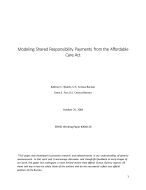Modeling Shared Responsibility Payments from the Affordable Care Act
Modeling Shared Responsibility Payments from the Affordable Care Act
Introduction
The Patient Protection and Affordable Care Act (ACA) was signed into law on March 23, 2010. The law includes a provision that requires each individual, beginning in 2014, to have minimum essential health care coverage for each month, qualify for an exemption from the requirement, or make a shared responsibility payment on his or her federal income tax return. The Tax Cuts and Jobs Act eliminates the individual shared responsibility provision starting on January 1, 2019. The shared responsibility provision is still in effect for tax year 2018.
The Current Population Survey (CPS) Annual Social and Economic (ASEC) tax model produces estimates of federal and state taxes, including estimates of several tax credits (such as the Earned Income Tax Credit, Child Tax Credit and Additional Child Tax Credit, etc.), but does not currently take into account the shared responsibility payment.
This paper explores the possibility of modeling and adding the shared responsibility payment into the CPS ASEC tax model. The inclusion of this payment in our tax model would more accurately capture families’ post tax and transfer income for the Supplemental Poverty Measure (SPM). The Census Bureau produces an alternative poverty estimate, known as the SPM, using data from the CPS ASEC. In attempting to model this provision of the ACA, we first look at how closely the predicted number of tax units with a shared responsibility payment and the aggregate payment amount align with figures from the Internal Revenue Service Statistics of Income (IRS SOI). Second, we examine how including the payment in the CPS ASEC tax model estimates changes poverty measurement in the SPM.
Overall, we overestimate the number of returns with a shared responsibility payment, the aggregate amount of payment, and the average payment per return in 2014, 2015, and 2016 when compared with targets from the IRS. In 2014, we overestimate the number of returns by 57 percent and the aggregate amount of payment by 180 percent. However, even with our overestimation of the penalty, we find that among the uninsured, the SPM rate only increases by 0.1 percentage points in 2014, by 0.2 percentage points in 2015, and by 0.4 percentage points in 2016 when we include the shared responsibility payment. At this point, we do not recommend adding this provision of the ACA to the CPS ASEC tax model because of the differences between our estimates and published aggregates for tax years 2014, 2015, and 2016 and because of changes in the tax law.




